Automatic grenade launcher Mk 18 Mod 0 (USA)
Elaboration of the issue of creating automatic grenade launchers of this or that purpose has been conducted in the USA since the end of the fifties. At the beginning of the next decade, the design of the first systems started, which soon managed to reach the adoption level. The ground forces showed an interest in such weapons, and they wanted to increase the firepower of the infantry, as well as the air force and naval forces, which wanted to supplement the machine guns on their equipment.
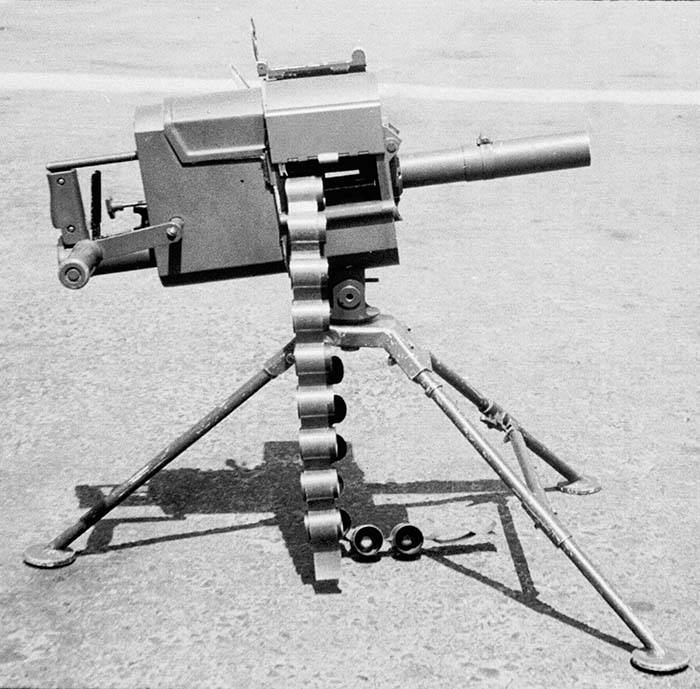
Automatic grenade launcher Mk 18 Mod 0 on the infantry machine. In the foreground hanging ribbon with empty cartridges. Photo by Smallarmsreview.com
One of the customers of the new automatic grenade launchers, oddly enough, became the US Navy. The command considered that numerous patrol boats should be armed not only with machine guns, but also with more serious weapons. The automatic system, throwing 40-mm fragmentation grenades, perfectly suited for this role. In 1962, the Navy placed an official order for such weapons. One of the promising projects, in accordance with the naval nomenclature, has received the working title Mk 18 Mod 0.
The development of a new product started at the end of 1962 of the year and was carried out by engineers at Honeywell Corporation. The customer wanted a weapon capable of making several hundred rounds per minute and sending fragmentation grenades to a distance of several thousand yards. In this case, the product should have been quite compact in size, allowing it to be used on equipment or with an infantry machine.
Obviously, the main problem for designers from Honeywell was the creation of automation capable of providing automatic fire using the 40x46 mm shot. It was found that automatics using the energy of the shot would seriously complicate the design of the weapon, and also lead to an increase in size and weight. For this reason, the engineers decided to use a long-forgotten system with a manual drive of automation, carried out with the help of rotation of a special handle.
By the beginning of 1964, gunsmiths completed the basic design work and formed the overall look of the future Mk 18 Mod 0. Later, the proposed design was refined and improved several times, but its main features remained unchanged. An automatic grenade launcher with a manual drive and a special design of internal units was brought to serial production.
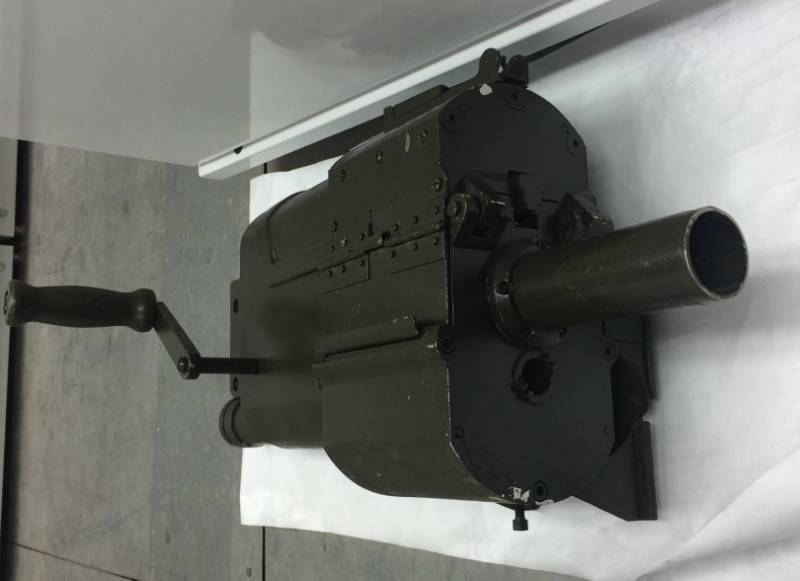
Product without a machine, front view right. The assembly of connection of details of a receiver and the drive handle is visible. Photos of Warisboring.com
Ready Mk 18 Mod 0 grenade launcher had a specific, but recognizable appearance. It could be recognized by a disproportionately large receiver box of a simplified form. The trunk was coming out of the box in the front, and part of the controls was placed on the back of it. On the sides were placed the means for working with the tape, and on the right behind the handle for controlling the mechanisms. At the bottom of the receiver mounted mount for installation on various compatible machines.
The stem box of the new grenade launcher was large and had a special shape; the same could be said about its flip cover. Two large parts were connected by a hinge: the lid could flip up and forward, opening access to internal mechanisms and allowing recharging or maintenance.
The receiver Mk 18 Mod 0 received a vertical front wall, in the upper part of which there were attachments for the barrel. The front part of its sides differed by a reduced height, which was due to the presence of a tape receiver and a window for removing the sleeves. Behind them, the height of the box increased. The back wall of the box was very tall and vertical. Bottom executed curved. The lid was a large metal device that occupied a little over a third of the total height of the box. The front of the cover was slightly larger.
At the level of the windows for feeding and withdrawing the tape, in the front of the receiver and the lid, the original devices were placed to interact with the shots. Their rear volumes were intended for the installation of a manual drive, automatic control systems and a firing mechanism. It is curious that inside the grenade launcher remained significant empty volumes, not occupied by the mechanisms or moving parts.
Constructors from Honeywell have found an interesting way to work with a fairly large ammunition, capable of providing automatic fire with minimal design complexity. At the same time, it was these simplified mechanisms that led to the need to increase the receiver and use a large lid.
Automation was built on the basis of a system called Split breech ("split breech"). Its main elements were two large rotors, which were placed in front of the receiver and its cover. Each such detail had six side trays designed to work with tape and grenades. One rotor was placed below the level of the barrel, the second - slightly higher. At the same time, at the level of the trunk, a pair of trays of two rotors were connected and formed the most real chamber, from which the shot was carried out.
The rear compartment of the receiver was given under the drive mechanisms and trigger. To the right of the box was the shaft of the L-shaped control handle. Through a bevel gear, the torque from the handle was transmitted to the longitudinal shaft connected to the simplest gearbox. The latter ensured the rotation of the lower rotor clockwise (when viewed in the direction of firing). A cam mechanism connected to the moving drummer and the drive of the upper rotor was placed on the drive shaft.
The cam on the shaft made the vertical lever swing back and forth, the upper arm of which was connected to the second rotor drive. Through the simplest mechanism, the movement of the lever was converted into rotation of the rotor (counterclockwise). The presence of the lever simplified the design of the mechanics, and in addition, it did not prevent to open the receiver cover: the lever itself remained inside the box, and the top rotor with a drive was freely separated from it.
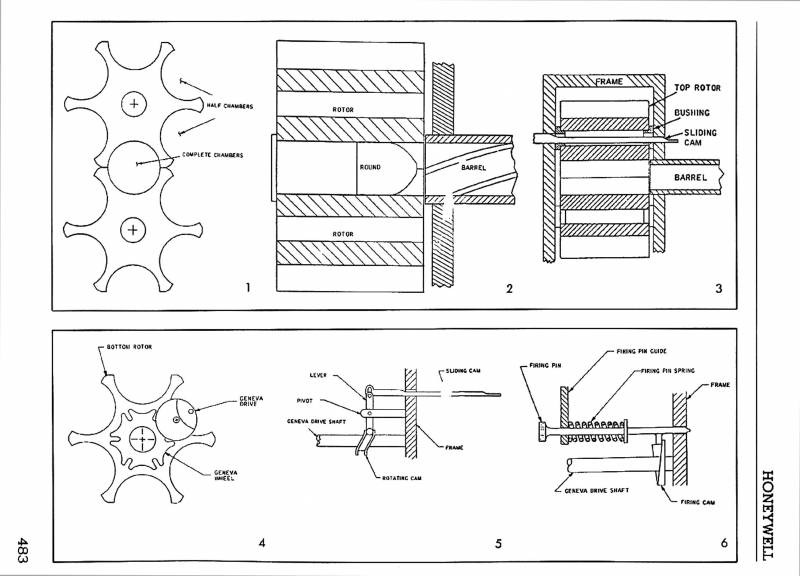
Automatic scheme of the split breech type (above) and the drummer device (below). Drawings from the book The Machine Gun
The weapons were equipped with a rifled barrel with a length of just 6 inches - 152 mm or 3,8 caliber. However, it should be noted that only the trunk itself had such a length. The 40X46 type grenade was noticeably shorter than the “detachable breech”, and therefore the front of the latter significantly increased the actual length of the barrel used to disperse the ammunition. However, despite this, the real characteristics of the fire could be insufficient. At a certain point, the problem of insufficient trunk length was proposed to be solved with the aid of a modular device tube 40 mm.
The Mk 18 Mod 0 grenade launcher received an uncomplicated double-action firing mechanism for the impactor type. At the level of the detachable breech in the rear cavity of the box was placed a longitudinal rod-drummer, which was put on a combat spring. The rotating cam from the hand drive system had to pull the drummer back and let him go, providing a shot. On the shank of the firing pin, which came out through the hole in the back wall of the box, there was a large metal arrow that served as a fuse. Its rotation around the longitudinal axis allowed us to translate USM into one of three modes: tape loading, blocking, or fire. Blocking the descent was carried out the easiest way. Drummer blocked at a safe distance from the breech.
The Mk 18 Mod 0 was supposed to use 40x46 mm shots transported in ribbons. Tapes were proposed to be made of synthetic fabric. A special machine was developed for equipping cartridge belts. She received ammunition and a pair of synthetic ribbons, and then wrapped the last around the grenades and soldered them among themselves. The finished tape was distinguished by sufficient strength and low weight. The strength of the material made it possible to reload the tape several times.
The tape was to be transported in a metal box. For the needs of the Navy have developed a box for 48 grenades. Together with the ammunition, he weighed 35 pounds - less than 16 kg. The infantry was asked to use a smaller box with half the capacity. She weighed 19 pounds or 8,6 kg.
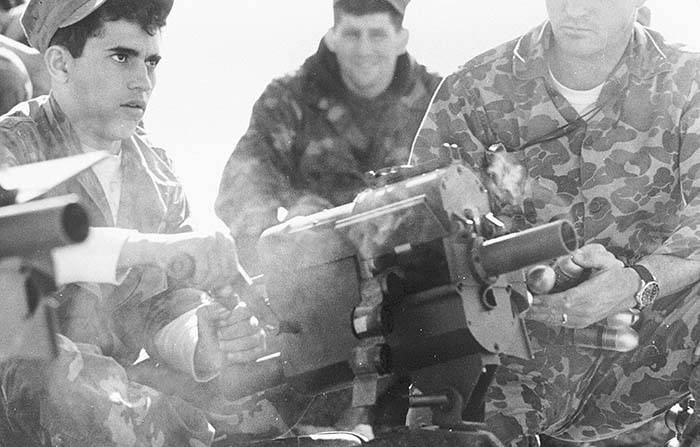
Personnel training in handling Mk 18 Mod 0. Photo by Smallarmsreview.com
New weapons differed specific ergonomics. It was suggested to direct it with the help of a large U-shaped handle mounted on the rear wall of the receiver. Under this handle was the arrow of the fuse. On the right side was placed the handle of the drive mechanisms. In this case, fire control was carried out only by rotating the latter. With the second hand, the shooter was asked to hold the fixed handle and point the weapon.
On the cover of the grenade launcher was placed a sight that corresponded to the fire qualities of the weapon. On the common rail were placed the front sight and the rear sight with front rings. Such a sight provided fire only with large elevation angles.
One of the main tasks of the project was solved, and therefore the new automatic grenade launcher was quite compact. Its total length was 22 inches (559 mm), the width given the control handle 13,5 inches (342 mm), height - 12 inches (304 mm). Product weight without machine - 19 pounds or 8,6 kg. The relatively short barrel accelerated the grenade to a speed of no more than 220 feet per second (about 65 m / s), however, allowed to fire at a distance of 1,5-2 km (on steep hinged trajectories).
Preparing the Mk 18 Mod 0 for shooting was not difficult. It was necessary to open the lock on the left side of the weapon and lift the lid. Further in the lower part of the detachable breech fit a grenade in the tape. After that, it was possible to close the lid and move the fuse to the “fire” position. The weapon was ready to fire.
When the hand-drive handle was rotated, the cam mechanism cocked and lowered the drummer, carrying out a shot. Further rotation of the handle pulled the drummer back, and then rotated a pair of rotors. The empty case together with the ribbon cell was removed to the right, and to the left the rotors captured a new shot and led it to the barrel. After that, USM again lowered the drummer. The rate of fire of such weapons is directly dependent on the physical capabilities of the shooter. In practice, this parameter achieved 230-250 shots per minute.
Experienced grenade launchers of the new model were submitted for testing in the 1964 year. Representatives of the US Navy familiarized themselves with these weapons and were pleased. The prototypes corresponded to the declared characteristics, and in some cases exceeded them. So, an experienced Mk 18 Mod 0 on tests made 5 thousands of shots without a single breakdown of automation. In this case, the customer wished the developers to make some changes to the existing design, aimed at improving the convenience and safety of handling weapons.
A compact and lightweight system with high firing characteristics should have been used on patrol boats and other light craft. In addition, shortly after the first tests "naval»The ground troops became interested in the grenade launcher. This interest resulted in several orders for mass production of weapons. Automatic grenade launchers Mk 18 Mod 0 went into series in 1965.
The release of a new type of grenade launchers did not last too long and was stopped in the 1968 year. In about three years, Honeywell released at least 1200 serial products. Weapons of different batches were intended for deliveries to the naval forces and land forces. It was assumed that grenade launchers for the fleet would be used with various installations for mounting on boats, and products with tripods were supplied to the army. It did not exclude the use of such weapons on self-propelled platforms.
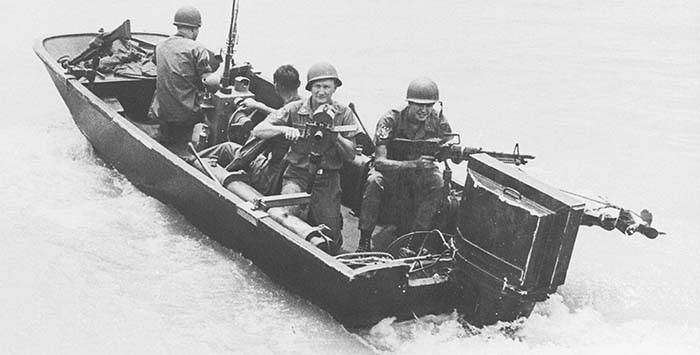
Patrol boat with mixed weapons. The second to the right fighter is driving a Mk 18 Mod 0 grenade launcher. Photo by Smallarmsreview.com
The Mk 18 Mod 0 automatic grenade launcher appeared shortly after the United States entered the Vietnam War, and therefore he immediately had to go to the front. In practice, it was confirmed that such a weapon - even with not the most advanced external drive - turns out to be a convenient means of fire support. 40-mm fragmentation grenades successfully complemented or replaced existing rifle or large-caliber machine guns. Such weapons performed well both in infantry and on board patrol boats.
According to the results of operation of grenade launchers in the army, several options for modernization were proposed. Thus, a new sight was proposed with a plate in its entirety, with several slots for different shooting distances. Also created new versions of machine tools and fixed installations. Of particular interest was the ship installation, built on the basis of a large box for ammunition. In the latter it was possible to place up to 200 grenades in the tape.
However, it should be noted that the career of the Mk 18 grenade launcher Mod 0 was not too long. Already in the 1968, a more advanced Mk 19 grenade launcher entered service, which had a lot of advantages over its predecessor. First of all, he was distinguished by the presence of complete automation, using the energy of the shot. In this regard, he could surpass the "hand" weapon in a number of important parameters. As a result, in the same year, the production of the Mk 18 Mod 0 was discontinued in favor of a newer model.
Until a certain time, two automatic grenade launchers were operated in parallel. However, the mass release of the new Mk 19 quickly enough allowed for rearmament. Not the most comfortable Mk 18 Mod 0 was almost universally decommissioned. Over the next few years, they officially remained in service, although out of mass use. Later, closing their needs with the new Mk 19, the US military finally abandoned the previous model.
The active operation of automatic grenade launchers Mk 18 Mod 0 lasted only a few years, but during this time such a weapon managed to leave a noticeable mark on stories american army. From the point of view of design, this sample was not particularly successful, and therefore, due to all the main characteristics, it lost to a newer weapon. However, it should be borne in mind that the Mk 18 Mod 0 appeared at the right time and made a significant contribution to the combat capability of the army. Despite the specific design and external drive, these weapons occupied their niche and solved combat missions until the appearance of more successful systems.
Based on:
http://forgottenweapons.com/
http://smallarmsreview.com/
https://warisboring.com/
http://guns.wikia.com/
Chinn GM The Machine Gun, Vol. Five. 1987.
Karpenko A.V. Automatic grenade launchers - weapons of the XX century. M .: Zeihgauz, 2007.
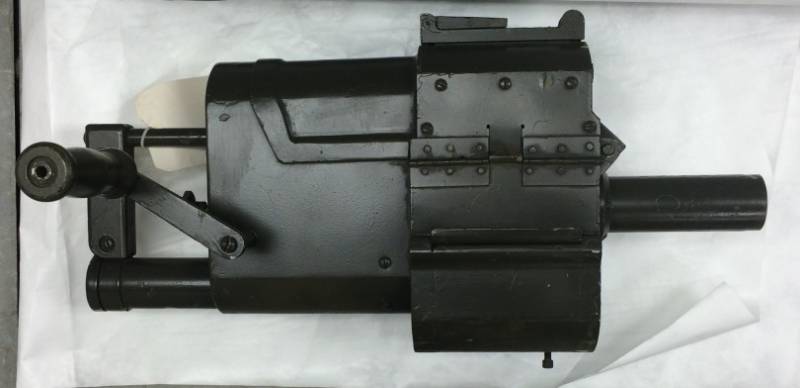
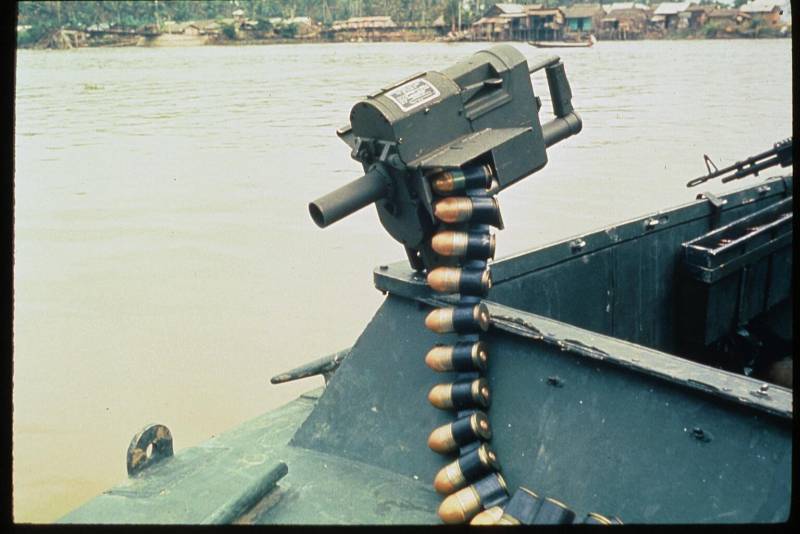
Information